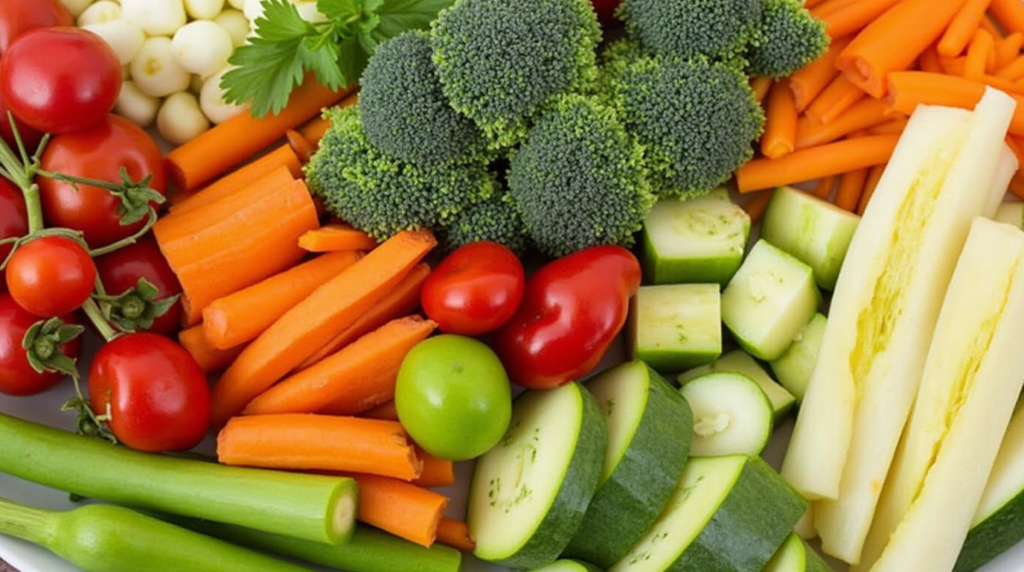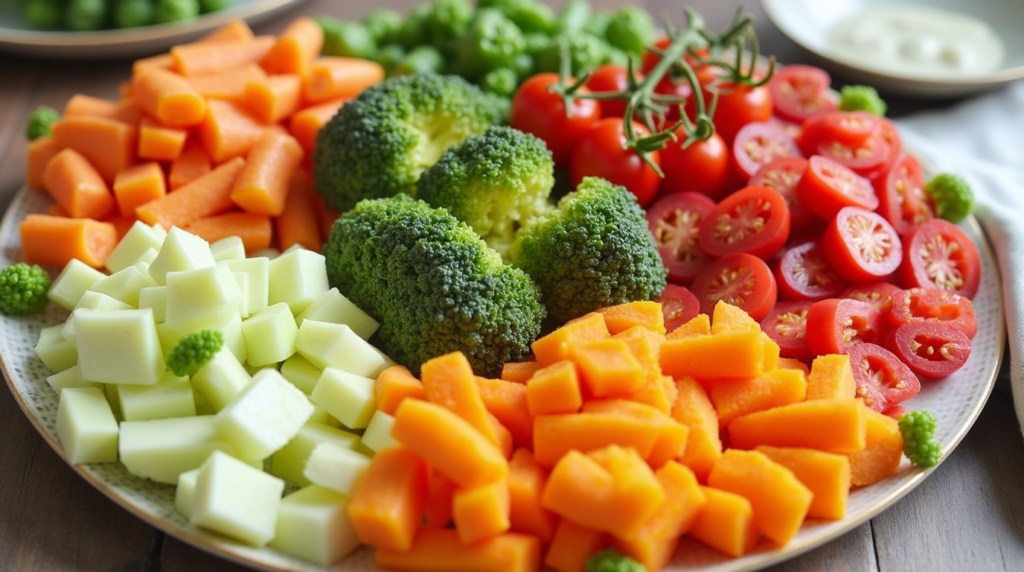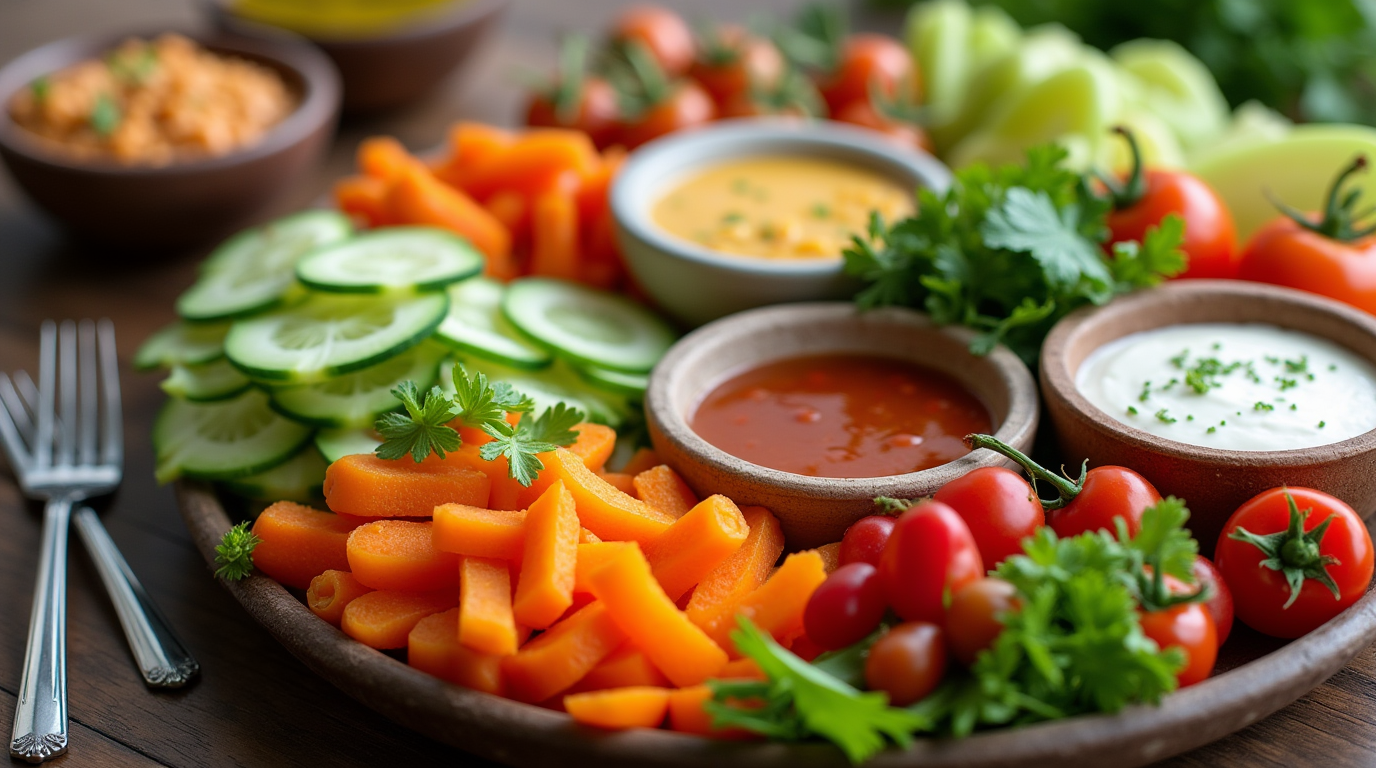When it comes to party snacks or casual get-togethers, there’s one thing that always seems to steal the show – the vegetable tray. Packed with color, crunch, and tons of health benefits, it’s a favorite that’s easy to prepare and even easier to devour. Whether you’re throwing a party, celebrating a holiday, or just looking to munch on something fresh and light, a veggie tray is a go-to.
In this guide, we’ll take a deep dive into the art of crafting the perfect vegetable tray—from picking out the best veggies to tips on arranging them beautifully. You’ll learn everything from the essentials to pro tips that will make your veggie tray the star of the show. Let’s get into it!
Table of contents
Introduction to Vegetable Trays
What is a Vegetable Tray?
A vegetable tray—also called a veggie platter or crudité platter—is exactly what it sounds like: a colorful arrangement of fresh, raw vegetables, typically served with a side of dip. Think crunchy carrots, vibrant bell peppers, fresh cucumbers, and those little cherry tomatoes that pop with every bite. The beauty of the veggie tray is in its simplicity and versatility. It can be as basic or as fancy as you want it to be, but one thing’s for sure: it’s always delicious.
The Appeal of Vegetable Trays at Gatherings
Let’s face it: after all those rich, heavy dishes at a party, a vegetable tray is like a breath of fresh air. Not only does it look great, but it’s a healthy option that satisfies the snack cravings without making you feel weighed down. It’s the perfect addition to any gathering—whether you’re hosting a BBQ, having a holiday dinner, or just hanging out with friends. The best part? It’s easy to assemble and everyone loves it. Plus, you can make it your own with a variety of fresh veggies and dips!

Selecting the Best Vegetables for Your Veggie Tray
Seasonal Vegetables to Include
When picking veggies for your vegetable tray, it’s always a good idea to go with what’s in season. Seasonal vegetables not only taste better, but they’re also more affordable. For spring and summer, think about including crisp cucumbers, sweet cherry tomatoes, and crunchy carrots. During the colder months, broccoli, cauliflower, and celery shine. Seasonal choices will bring freshness to your veggie tray, and hey, they’re great for the environment too! Plus, when veggies are in season, they tend to have more flavor—who doesn’t love a juicy tomato in the summer?
Balancing Colors and Textures
A vegetable tray isn’t just about taste—it’s also about visual appeal! Try to include a variety of colors and textures. You want your tray to be as fun to look at as it is to eat. Mixing crunchy vegetables like celery with softer ones like cucumber or sugar snap peas creates a great contrast. The more colorful, the better! Think about adding pops of yellow with yellow peppers or purple with purple carrots. A rainbow of veggies isn’t just good for the eyes; it’s also a great way to get a variety of nutrients.
Preparing Vegetables for Presentation
Cleaning and Cutting Techniques
Before you can start assembling your vegetable tray, you need to give those veggies a little TLC. First off, give everything a good wash—no one likes dirt in their dips! After that, cut your vegetables into bite-sized pieces. The key here is consistency. You want the pieces to be uniform so your guests aren’t struggling with large chunks of veggies. For example, slice your carrots into sticks, and chop your bell peppers into squares or strips. Consistency in size will make the tray more inviting and easier to eat.
Blanching for Enhanced Flavor and Color
Here’s a pro tip: blanching certain vegetables, like broccoli or asparagus, can give them a brighter color and a more vibrant taste. Blanching is super simple—just boil water, dip the veggies for a minute or two, then quickly transfer them to ice water. This process helps preserve the veggies’ crunch while enhancing their natural color. It’s an easy step that makes your vegetable tray look more professional, and the flavor is a huge bonus!
Creative Arrangements and Presentation Ideas
Designing an Attractive Layout
Now that you’ve chosen your veggies, it’s time to make your vegetable tray look as good as it tastes! The key to a beautiful veggie platter is a balanced, symmetrical arrangement. Place the larger veggies like broccoli or cauliflower towards the center, and scatter the smaller veggies, like cherry tomatoes or baby carrots, around them. If you’re feeling extra, try stacking some of the veggies to add height. The goal is to keep the tray visually interesting so that it draws guests in! A circular arrangement can be especially appealing, but feel free to get creative and mix it up based on your event’s theme.
Incorporating Garnishes and Decorative Elements
To take your vegetable tray to the next level, add some garnishes! Fresh herbs like parsley, basil, or rosemary can bring in a pop of green. You could also use edible flowers or even artfully arrange sliced lemons or limes around the edges. These small touches make a big difference, making your veggie platter look more like a work of art. When everything’s arranged beautifully, your guests won’t just be grabbing veggies—they’ll be admiring the platter too!

Choosing and Preparing Dips and Accompaniments
Popular Dip Options
Let’s talk about the dips—because, let’s face it, the dip makes the vegetable tray! You can’t go wrong with the classics, like creamy ranch, tangy hummus, or zesty guacamole. If you’re feeling adventurous, try something a little different, like a spinach artichoke dip or a yogurt-based dip. Dips not only add flavor, but they also add a fun element to the tray. Make sure to have a variety of dips to satisfy different tastes.
Homemade vs. Store-Bought Dips
Homemade dips definitely have the upper hand when it comes to freshness and taste, but we get it—sometimes you’re short on time. Store-bought dips are totally fine, especially if you’re in a rush. However, adding a sprinkle of fresh herbs or a squeeze of lemon juice can give those store-bought options a little extra oomph. If you’re looking for quick, easy ideas, check out our easy dip recipes for inspiration!
For more delicious recipes, check out our other articles on fun and creative party snacks!
Dietary Considerations and Customizations
Accommodating Dietary Restrictions
When making a vegetable tray, it’s important to keep dietary needs in mind. Thankfully, vegetable trays are naturally friendly to many different diets! They’re perfect for vegan, vegetarian, and gluten-free guests. If you’re serving a crowd with a variety of dietary restrictions, consider adding a few special dips like guacamole or olive tapenade—both are naturally vegan and gluten-free. To keep it more inclusive, always check that your dips don’t contain any hidden dairy or gluten ingredients. Adding a mix of veggies that cater to these needs, such as carrots, cucumbers, and cherry tomatoes, ensures everyone can enjoy the spread without worry.
Incorporating International Flavors
Don’t be afraid to think outside the box with your vegetable tray! Spice things up by incorporating international flavors. Add a tzatziki dip for a Mediterranean twist, or use sriracha mayo for a kick of heat. You can even bring in some Asian flair with soy sauce or sesame oil in your dips. This variety of flavors will make your veggie platter stand out and excite your guests.
Tips for Serving and Storing Your Vegetable Tray
Optimal Serving Temperatures
To make your vegetable tray look and taste its best, it’s essential to serve it at the right temperature. Fresh veggies are best served chilled, so make sure to refrigerate your platter before serving. You can even pop it in the fridge for an hour or two before your guests arrive. If you have dips on the side, keep those chilled too. An easy trick is to place the dips in small bowls inside a larger dish filled with ice. This keeps everything cool and crisp throughout the event!
Storage Solutions for Freshness
If you have leftovers (lucky you!), proper storage is key to keeping your vegetable tray fresh for the next day. Store any uneaten veggies in an airtight container and refrigerate them as soon as possible. If you’ve got leftover dips, make sure those are sealed up tight too. Just be aware that some veggies, like avocados in guacamole, may not store as well and can oxidize or brown quickly. To prevent this, try adding a bit of lemon juice to the dips for extra freshness.
Final Thoughts on Creating the Perfect Vegetable Tray
Why a Vegetable Tray is Always a Winner
The vegetable tray is one of those timeless party favorites that never disappoints. Not only is it super easy to assemble, but it’s also incredibly versatile. Whether you’re feeding a crowd or just looking for a quick snack, a veggie platter has something for everyone. With so many options for veggies and dips, you can easily customize it to fit any occasion. It’s a refreshing, healthy snack that offers something light yet satisfying—perfect for balancing out the heavier dishes at your event.
Make It Yours!
The best part about a vegetable tray? It’s totally up to you! Feel free to get creative with your veggie selection, dipping options, and presentation. Whether you’re keeping it simple with a few ingredients or going all-out with unique combinations, your vegetable tray is sure to be a hit at your next gathering!
FAQs
How Long Can I Keep a Vegetable Tray Out?
You can safely keep a vegetable tray out for about 2 hours at room temperature. After that, it’s best to store any leftovers in the fridge to maintain freshness. If you’re hosting a long event, consider keeping the veggies on ice to help them stay crisp and cool.
What Should I Put in My Vegetable Tray?
A great vegetable tray includes a variety of colorful, crunchy veggies like carrots, celery, cucumbers, cherry tomatoes, and bell peppers. You can also add dips like hummus, ranch, or guacamole for extra flavor.
What Are the Best Veggies for a Veggie Tray?
The best veggies for a veggie tray are those that are easy to dip and eat raw. Popular options include carrots, celery, cucumbers, cherry tomatoes, and snap peas. Choose a mix of textures and colors for a more appealing and satisfying platter.
Can I Add Cheese or Other Non-Vegetable Items to the Tray?
Absolutely! While the vegetable tray is usually veggie-focused, adding a little variety can be fun. Some people love having cubes of cheese, olives, or even hard-boiled eggs alongside their veggies. Just make sure to offer options that complement the fresh veggies without overpowering them.


1 thought on “The Ultimate Guide to Crafting the Perfect Vegetable Tray”